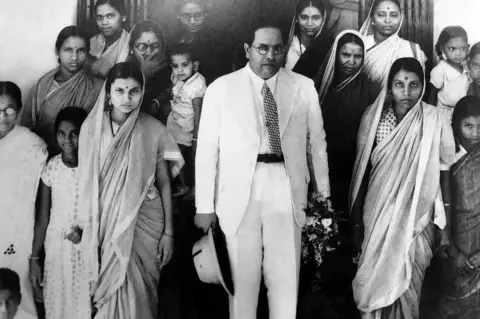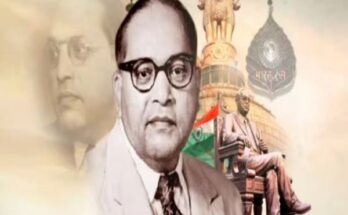by: Bindu Ammini

Gender in social justice:
Dr BR Ambedkar, the chief architect of the Indian Constitution and independent India’s first Law Minister, remains a towering figure in the struggle for social justice. His legacy is often celebrated for dismantling caste hierarchies and empowering the Dalit and other marginalised communities. What is less acknowledged, yet equally transformative, is his radical vision for women’s liberation, especially the empowerment and liberation of Dalit women.
Ambedkar never viewed caste and gender as isolated structures of oppression. For him, the caste system was inherently patriarchal, and patriarchy was deeply entrenched in Brahmanical Hinduism. In his works, including The Annihilation of Caste, he exposed how religious doctrines not only sanctioned caste-based hierarchies, but also dictated women’s subjugation.
Dalit women were positioned at the intersection of caste, class, and gender. Ambedkar’s feminist approach was, therefore, not abstract or elitist, but grounded in the lived realities of their double or triple marginalisation.
Long before feminist discourse entered mainstream academia in India, Ambedkar articulated a distinctly rooted, intersectional approach to gender justice, laying the foundation for what we now identify as Dalit feminism.
He recognised that the liberation of Dalit women was central to the emancipation of the entire Dalit community.
As the chairman of the Drafting Committee of the Indian Constitution, Ambedkar ensured that gender equality was enshrined in the very fabric of the nation. Articles 14, 15, and 16, which prohibit discrimination based on sex and caste, are a direct result of his insistence on an inclusive framework that permitted affirmative action to integrate the marginalised in the mainstream. He argued for equal access to education, employment, and civil liberties for women, anticipating the feminist critiques that would emerge much later.
Liberation through education
Ambedkar was not only a legislator or theoretician, but also a social reformer who worked on the ground. Many of his initiatives were for women.
He encouraged Dalit women to form collectives and participate in public life. In his speeches made at women’s gatherings, he urged them to educate themselves, be financially independent, and challenge oppressive traditions.
Ambedkar believed education was the most potent tool for liberation. He encouraged Dalit women, in particular, to break the shackles of tradition, seek knowledge, and participate in the public sphere. He facilitated hostels and scholarships for Dalit girls and spoke out against the denial of education to women by orthodox systems.
He believed that unless women were educated and economically independent, the dream of equality would remain hollow.
Power of collective action
In the rigid social terrain of early 20th century India, where caste hierarchy worked hand-in-glove with patriarchy, Dalit women were not granted the right to grieve aloud, let alone speak in public. Ambedkar’s encouragement of their self-organisation was a radical political move rooted in his understanding that the emancipation of the Dalit community could not be achieved without the absolute liberation of Dalit women.
His belief in the power of collective action led him to actively promote the formation of Mahila Mandals – autonomous women’s collectives – where Dalit women could come together, not just to share their burdens, but to voice their politics.
The Mahila Mandals were more than meeting spaces — they were schools of political consciousness, where women learned to speak, question, organise, and resist. They discussed social reform, legal rights, child bearing, health, and even inter-caste violence. These collectives became their first steps toward reclaiming public space, political legacy, and personal dignity.
At these gatherings, Ambedkar spoke as a comrade, a visionary, and a reformer. He called on women to not merely to read and write, but to critically understand the systems that subjugated them. He urged them to seek economic independence to work, earn, and make decisions for themselves and their families.
He reminded them that true dignity comes not from independence, but from self-respect earned through struggle and assertion.
‘Born to rise’
Ambedkar did not romanticise motherhood or womanhood. Instead, he gave a constant reminder: “You are not born to suffer. You are born to rise.” These words echoed in the minds of women who had been taught for centuries to keep their heads bowed.
He challenged Brahmanical patriarchal practices that justified child marriage, widowhood taboos, and sexual exploitation of Dalit women by dominant caste men. He insisted that these customs were not sacred and were tools of domination, and said it is the duty of every Dalit woman to expose and reject them.
Perhaps his most courageous legislative intervention was the Hindu Code Bill, which sought to reform Hindu personal laws by granting women the rights to property, divorce, and inheritance. Though the Bill was diluted after facing opposition from conservative forces, Ambedkar’s commitment was unwavering. He resigned from his post as Law Minister in protest, declaring that he could not be part of a government that denied justice to women.
‘Annihilate caste to empower women’
Ambedkar’s public burning of the Manusmriti in 1927 was not merely a symbolic act against caste oppression, but a radical feminist gesture that marked the rupture with the ideological foundation of Brahmanical patriarchy. The text, which justifies the degradation of women, especially those of lowered castes, was rejected in its entirety by Ambedkar.
In setting Manusmriti on fire, Ambedkar ignited a movement that challenged not just caste supremacy, but also the religious sanction behind women’s oppression, especially that of Dalit and Sudra women who bore the heaviest burden of its decrees.
The silence of dominant caste feminists on this act is telling — it reminds us that Dalit feminism as envisioned by Ambedkar emerged not from drawing room debates, but from the fires of resistance and from the courage to reject inherited systems of violence.
Mainstream feminism often misses what Ambedkar had seen clearly. He was certain that without addressing caste, liberation of women remains incomplete. For Dalit women, empowerment cannot be separated from the annihilation of caste, and Ambedkar’s politics continue to offer the sharpest tools to fight that battle.
The legacy of Ambedkar’s work with Dalit women lives on in countless Dalit feminist movements, self-help groups, and resistance campaigns. The seeds sown in Mahila Mandals have grown into forests of defiance.
At the roots of Dalit feminism lie his words, his courage, and his uncompromising belief in equality for all. Dalit feminist scholars and activists like Dakshayani Velayudhan, Ruth Manorama, Gogu Shyamala, Urmila Pawar, Babytai Kamble, Shantabai Kamble, Rekha Raj, and Cynthia Stephen continue to echo Ambedkar’s insistence on an anti-caste, anti-patriarchal framework.
‘Organise, educate, liberate’
To remember Ambedkar only as a jurist or Dalit icon is to erase his radical contributions to gender justice. His vision was never limited to legal reforms — it was a call for social revolution. As we reclaim his legacy today, we must center the voices of those Dalit women whose liberation was always at the heart of his dream for a just society.
In a world still shaped by systemic exclusions, Ambedkar’s call to Dalit women remains urgent and unyielding: organise, educate, and liberate. Let us rise, then, not in memory alone, but in the living fire of his unfinished revolution.
Dr BR Ambedkar’s contributions to women’s empowerment were foundational and far ahead of his time. His work inspires Dalit feminists, gender justice activists, and all who believe in an India where dignity, equality, and justice are not just constitutional ideals, but lived realities.
Source: The News Minutes



